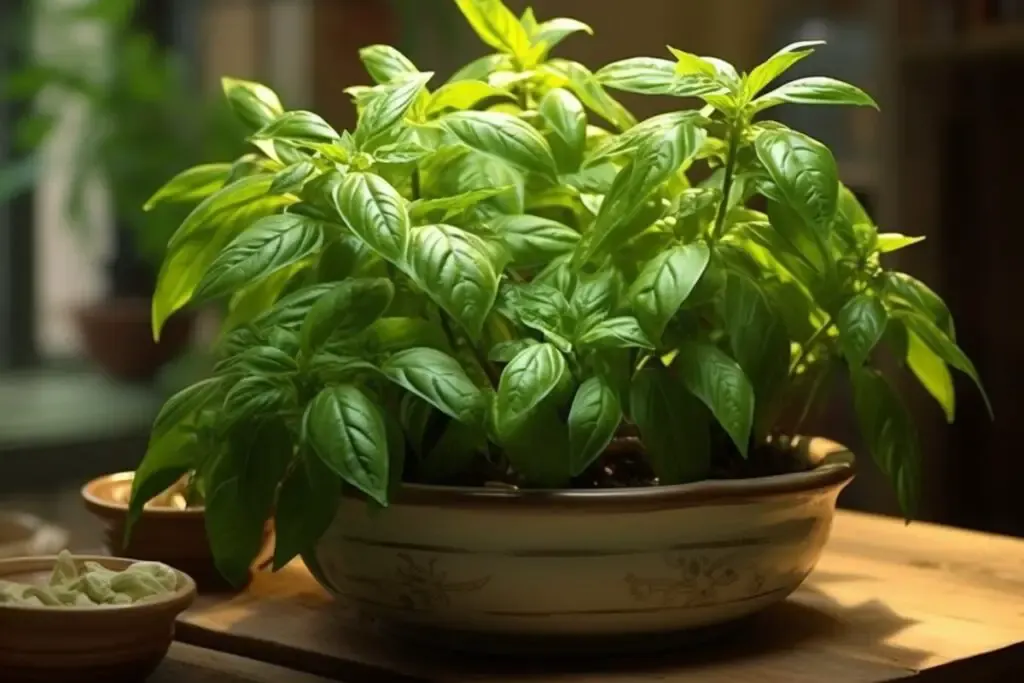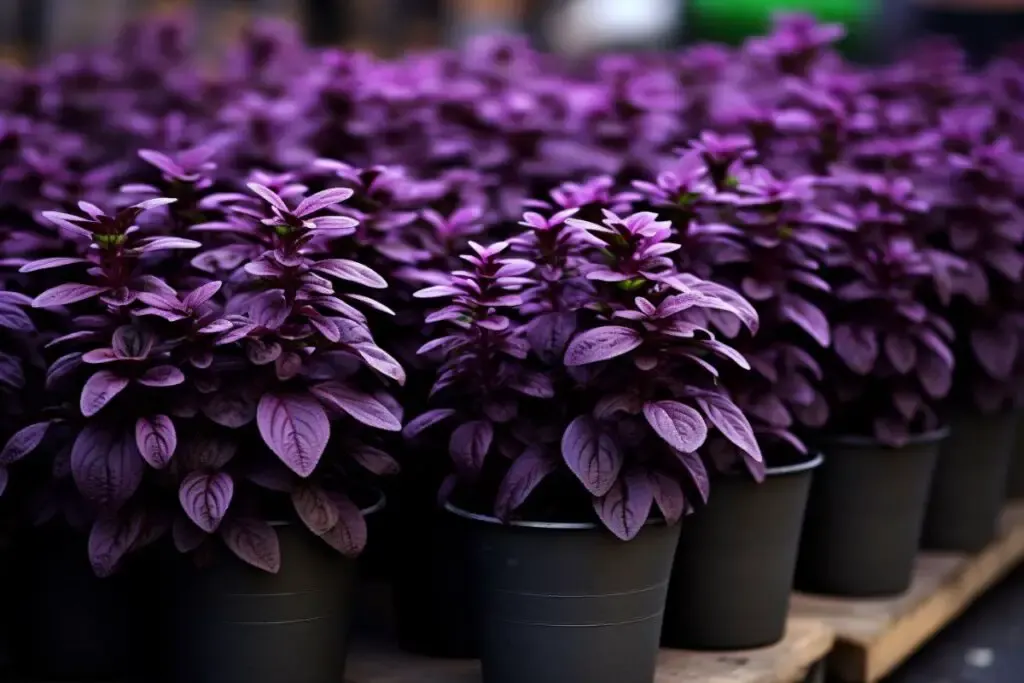Basil: The Aromatic Herb That Thrives in Your Home. There’s a simple joy in plucking fresh herbs right from your windowsill, transforming an ordinary dish into something extraordinary with just a few leaves. Basil, with its lush green foliage and enticing aroma, is not just the heart of pesto but also a gardener’s delight.
The good news for enthusiasts with limited space is that basil is perfectly suited to pot life. It’s a plant that not only adapts well to container gardening but also offers up its vibrant leaves with little fuss, provided you meet its basic needs.
Whether you’re a seasoned gardener or a green-thumbed newbie, growing basil in pots is an exercise in simplicity and satisfaction. Let’s dig into the essentials of cultivating this aromatic herb and how you can do it like an expert!
Does Basil Grow Well in Pots?
Absolutely! Basil is one of those wonderful plants that take to pot growing as naturally as it does in the ground. Its compact root system and love for warm conditions make it ideal for container gardening. With pots, you have the advantage of moving your plants to capture the best sunlight or to protect them from harsh weather—flexibility that garden beds just can’t offer.
When grown in pots, basil can be kept close at hand, on a kitchen windowsill, a sunny balcony, or a patio, making it not only a culinary asset but a decorative one too.
The key to success lies in choosing the right variety, and pot size, and ensuring proper care—factors that will result in a bountiful harvest of this delightful herb.
Best Basil Varieties for Pots
While most basil varieties will do well in containers, some are tailor-made for the compact space and can flourish with the right care.
Here are three varieties that I’ve found to be particularly well-suited for pot cultivation, each bringing its unique flavor and flair to your garden and your plate.
1. Sweet Basil

The quintessential basil, known for its large, aromatic leaves, is a no-brainer for potted herb gardening. Sweet basil is versatile, flourishing in both the kitchen and the container.
Its vigorous growth and propensity to yield a generous harvest make it a favorite among gardeners. The lush green leaves are not just for show; they’re the backbone of countless recipes, from fresh salads to that classic Italian pesto.
2. Greek Basil

If you’re looking for a basil that’s as decorative as it is tasty, Greek basil is your go-to. This variety forms a naturally rounded bush, sporting tiny, flavorful leaves.
It’s less common than sweet basil but equally enchanting, offering a more concentrated flavor that’s perfect for a hearty pasta sauce. Greek basil’s compact size makes it ideal for smaller pots and even as a table centerpiece.
3. Purple Basil

For those who love a dash of color, purple basil provides a striking contrast with its deep violet leaves and a slightly spicier flavor profile.
It’s not just the color that sets it apart; the leaves have a slightly more robust texture and a clove-like aroma that can add an unexpected twist to traditional basil dishes. In a pot, it’s a visual delight and a conversation starter.
How to Grow and Care For Basil in Pots
Transforming your balcony, patio, or windowsill into a verdant herb haven starts with knowing the essentials of basil care. When it comes to potted basil, every element of its environment—from the soil to the sky—plays a role in the vigor of its growth. Let’s break down the must-knows for budding basil growers.
Planting
The first step to a flourishing basil plant begins with planting. Start with high-quality seeds or purchase young plants from your local nursery. If you’re starting with seeds, sow them superficially, barely covering them with soil.
Basil seeds need light to germinate, so a thin layer of soil is all they require. Keep the soil moist until the seeds germinate, which typically takes about 7-10 days. Once the seedlings have sprouted and have grown a couple of sets of true leaves, they are ready to be transplanted into individual pots.
Pot Size
Basil doesn’t have a deep root system, so there’s no need for a deep pot. However, you do want to give the roots ample room to spread out.
A pot that’s at least 8-10 inches in diameter should suffice for a single basil plant. If you’re looking to grow several plants in one container, opt for a larger pot, ensuring each plant has enough space to grow without overcrowding.
Light
Light is like a golden thread in the tapestry of basil care—it’s that crucial. Basil loves the sun and requires about 6-8 hours of direct light daily to thrive.
When growing basil indoors, a south-facing window is ideal. If your basil isn’t getting enough light, you’ll notice it becoming leggy and less vibrant. In such cases, supplementing with a grow light can keep your basil bushy and happy.
Soil
This herb is not fussy about soil as long as it is well-draining. A good quality potting mix should do the trick, ideally one that’s rich in organic matter.
You can also make your mix by combining equal parts of peat moss, perlite, and compost. This will provide good aeration and moisture retention, ensuring that your basil’s roots are healthy and your plants are vibrant.
Water
Basil loves moisture but despises soggy feet. Overwatering is a common misstep, so ensure your pots have drainage holes. Water your basil when the top inch of soil feels dry to the touch.
Be consistent with watering, and try to avoid getting water on the leaves, as this can promote disease. The frequency will depend on the climate, with more water required in hotter, drier conditions.
Temperature and Humidity
Basil is a warm-weather herb, thriving in temperatures between 70°F and 80°F. If you’re growing basil outside, be mindful of dropping temperatures, as basil is sensitive to cold and will not survive a frost.
Humidity is generally not an issue for basil, but if you’re in an especially arid climate, occasional misting or a pebble tray can help.
Fertilizer
While basil isn’t a heavy feeder, it will benefit from occasional fertilization. A balanced, water-soluble fertilizer applied every four to six weeks during the growing season can encourage fuller growth and a more abundant harvest.
Alternatively, a slow-release granular fertilizer can be mixed into the soil at the beginning of the season for steady nutrition.
Pruning Potted Basil
To keep your potted basil lush and bushy, pruning is your secret ingredient. It’s not just about snipping away what you need for your latest culinary masterpiece; it’s about encouraging growth and vitality.
Start by regularly pinching off the tip of each stem, just above a leaf pair. This technique encourages the plant to branch out, becoming fuller rather than leggy and spindly. As your basil grows, be bold in removing any leaves that are older and lower on the stem, which can become tough and less flavorful. Pruning is not a one-and-done deal; it’s a continual process that rewards you with a healthy, leafy plant.
When flowers start to form, pinch them off promptly. Flowering can cause your basil to become bitter and can also signal the plant to stop producing leaves. By keeping it in a vegetative state, you ensure a consistent supply of tender, aromatic leaves.
Remember, every time you prune, you’re not just shaping the plant; you’re harvesting and prompting more growth. It’s a delightful cycle of growth and reward that’s incredibly satisfying.
Overwintering
Overwintering basil can be a bit of a challenge since it’s naturally a warm-season plant, but it’s not impossible. As temperatures start to drop, move your potted basil indoors to a warm spot with plenty of sunlight. If you lack sufficient natural light, a grow light can make a world of difference.
Cut back your basil plant by about one-third to help it adjust to the lower light levels it’ll encounter indoors. This will also help to keep it manageable in size. Make sure the room is not too dry, as indoor heating can reduce humidity levels drastically. A small humidifier or a pebble tray with water can help maintain the humidity levels.
Be mindful of watering; your basil will require less water indoors since the rate of evaporation is lower. Let the soil dry out a bit more between watering to prevent root rot. With some care, you can keep your basil alive through the winter, ready to thrive again come spring.
With these practices, your potted basil can not only survive the winter but continue to be a source of fresh flavor for your kitchen all year round.

